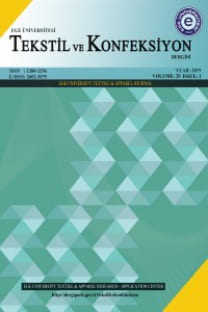AN INVESTIGATION ON SOUND GENERATION IN DIFFERENT FABRICS
Waving sound, frictional sound, fabrics rustle sound, acoustic property, tactile property, fabric handle
AN INVESTIGATION ON SOUND GENERATION IN DIFFERENT FABRICS
Waving sound, frictional sound, fabrics rustle sound, acoustic property, tactile property, fabric handle,
___
- 1. Kim, C.; Yang, Y.; Cho, G. Characteristics of Sounds Generated from Vapor Permeable Water Repellent Fabrics by Low-speed Frictions, Fibers and Polymers, 2008, Vol.9, No.5, 639-645
- 2. Kim, C.; Cho, G.; Hong, K.A. Shim, H.J. Sound Characteristics According to Cross-Sectional Shapes of Fibers, Fibers and Polymers, 2003, Vol.4, No.4, pp. 199-203
- 3. Na, Y.; Cho, G.; Variations in Sensibility to Fabric Frictional Sound by Fiber Type and Subject, Textile Research Journal; 2003, 73; 837
- 4. Jin, E.; Cho, G. Effect of Frictional Sound of Combat Uniform Fabrics on Autonomic Nervous System (ANS) Responses, Fibers and Polymers, 2013, Vol.14, No.3, 500-505
- 5. Yi, E.;Cho, G. Fabric-sound Classification by Autoregressive Parameters, Journal of the Textile Institute, 2000, 91: 4, 530 -545
- 6. Cho, J.; Cho,G., Determining the Psychoacoustic Parameters That Affect Subjective Sensation of Fabric Sounds at Given Sound Pressures, Textile Research Journal, 2007, 77; polypropylene. 29-37
- 7. McCullough, E.A. A Comparison of the Comfort and Hand Characteristics of Lining Fabrics, GAMA (Global Acetate Manufacturers Association) Technical Report # 99-08, 1999
- 8. Kim, C.; Cho, G.; Yoon, H.; Park, S. Characteristics of Rustling Sounds Created by the Structure of Polyester Warp Knitted Fabrics, Textile Research Journal, 2003, 73; pp.685 -691
- 9. Cho S and Cho G. Minimizing Frictional Sound of PU-Nanoweb and PTFE Film Laminated Vapor Permeable Water Repellent Fabrics. Fibers and Polymers 2012; Vol.13, No:1:123-129, DOI 10.1007/s12221-012-0123-y
- 10. Yang, Y., Kim, C., Park, J., You, H., Cho, G., Application of the Real Fabric Frictional Speeds to the Fabric Sound Analysis using Water Repellent Fabrics, Fibers and Polymers 2009, Vol.10, No.4, 557-561, DOI 10.1007/s12221-009-0557-z
- 11. Park C., Cho G., Analysis of Acoustic Characteristics of Fabrics in Terms of Mechanical Properties, Fibers and Polymers 2012; Vol.13, No: 3: 403-410.
- 11
- 12. Wang P-N, Ho M-H, Cheng K-B, Murray R, Lin Ch-H. Study on the Friction Sound Properties of Natural-Fiber Woven Fabrics, Fibres & Textiles in Eastern Europe 2017; 25, 2(122): 34-42. DOI: 10.5604/12303666.1228183
- 13. http://www.deltaohm.com/ver2008/uk/depliant/hd2010UC_D_uk.pdf
- 14. Bishop, DP. Fabrics: Sensory and Mechanical Properties. Text. Prog. 1996, 26, 12-13, 41.
- 15. Giordano, B.L.; Avanzini, F. Chapter 4 Perception and Synthesis of Sound-Generating Materials, Springer-Verlag London 2014, M. Di Luca (ed.), Multisensory Softness, Springer Series on Touch and Haptic Systems, pp 49-84
- 16. http://www.itl.nist.gov/div898/handbook/eda/section3/eda35h1.htm
- 17. Cho, G.; Casali, J.G.; Yi, E. Effect of Fabric Sound and Touch on Human Subjective Sensation, December, Fibers Polym. 2001, 2(4):196–202
- 18. Cho G.; Kim C.; Cho J.; Ha J. Physiological Signal Analyses of Frictional Sound by Structural Parameters of Warp Knitted Fabrics, Fibers Polym. 2005, March, 6(1):89– 94
- 19. http://www.textileweb.com/doc/pneumatic-fabric-stiffness-tester-0001
- 20. http://aeipro.com/files/congresos/2009badajoz/ciip09_1728_1836.2716.pdf
- 21. Saville, B.P., Physical Testing of Textiles, Woodhead Publishing Ltd, Cambridge England, ISBN 0849305683, 1999, 310p.
- 22. Cooper, C.J., 2013, Acoustics and Friction of Apparel and Model Fabrics, and
- Consumer Perceptions of Fabric Sounds, PhD Thesis, School of Chemical Engineering, The University of Birmingham
- ISSN: 1300-3356
- Yayın Aralığı: 4
- Yayıncı: Ege Üniversitesi Tekstil ve Konfeksiyon Araştırma & Uygulama Merkezi
Industrial cotton waste: Recycling, Reclaimed fiber behavior and quality prediction of its blend
Wanassi BÉCHİR, Azouz BÉCHİR, Ben Hassen MOHAMED
GELİNLİK ÜRETİMİNDE MODÜLER ÜRÜN GELİŞTİRME ÜZERİNE BİR ARAŞTIRMA
Seda KULELİ, Zümrüt BAHADIR ÜNAL
Keti VENTURA, Gökay ÇİÇEKLİ, Serkan Utku ÖZTÜRK
ÖRME SÜRECİNDE BULANIK TOPSIS KULLANARAK HATA TÜRÜ VE ETKİLERİ ANALİZİ
AN INVESTIGATION ON SOUND GENERATION IN DIFFERENT FABRICS
Gamze SÜPÜREN MENGÜÇ, Aslı DEMİR, Faruk BOZDOĞAN, Necdet SEVENTEKİN
Zar Örgülü Kumaşların Gama Radyasyonu Kalkanlama Etkinliği Üzerine Bir Araştırma
